MEME whale trading password: high-frequency gaming and covert manipulation with high profits
Written by: Frank, PANews
The MEME market is always full of myths about getting rich overnight, but there are very few players who can actually make profits consistently. How do real MEME top players make consistent profits? Is there a so-called "holy grail" in MEME trading? PANews conducted an in-depth analysis of the trading behavior of the top three profitable players in OKX wallets in the past three months.
The trading strategies of these top players not only showcase the diversity of MEME coin trading but also shed light on the unknown complexities and potential pitfalls in this high-stakes field.
This analysis will be carried out from several perspectives, such as token buying preferences, maximum single profit, maximum single loss, trading frequency, position size, and buying timing.
Cupsey: Hunt for diamonds in high-frequency rushes
Cupsey (suqh5sHtr8HyJ7q8scBimULPkPpA557prMG47xCHQfK, Twitter: @Cupseyy) is the number one address in terms of income in the past 3 months on the OKX Wallet Bull List. In the past three months, the revenue is about $5.14 million, with a win rate of 67.7%, and Cupsey also has 137,400 monthly followers on Twitter.

PANews analysis found that Cupsey's daily trading style belongs to a high-frequency front-running strategy, that is, investing a certain percentage of funds to buy the token while it has just opened, and then liquidating the position after 1 minute or tens of seconds. Due to Cupsey's huge trading volume, reaching 95,000 in 30 days, it is not possible to provide a detailed analysis of its overall trading strategy. PANews selected Cupsey's recent random trades as well as the most profitable and loser trades for analysis.
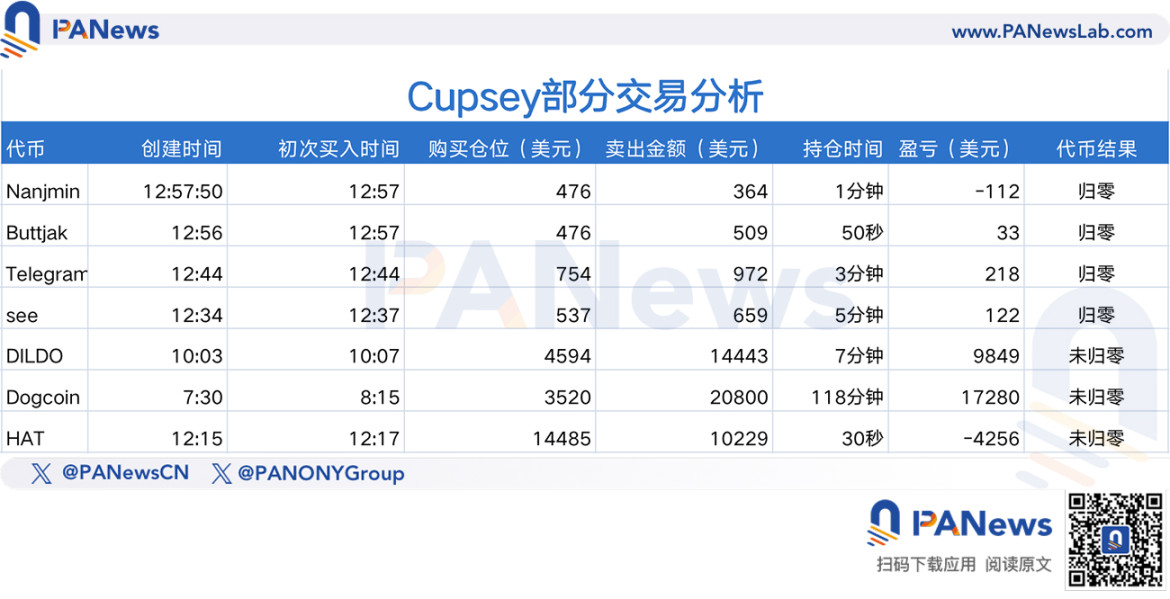
In terms of transaction frequency, Cupsey has made an average of about 910 transactions per day in the past seven days, and judging from the latest transactions, he prefers to buy tokens with the same proportion of funds within a few minutes of the token's launch or opening, usually around 3 SOL. Then make the initial sale within tens of seconds to minutes, and if the token meets certain criteria, Cupsey will also choose to call up the position with a single fund of about $30, usually about 10 more times. Cupsey's profitability targets are usually not high, ranging from a few tens of dollars to around $200. Obviously, his logic is not to appear according to a fixed profit and loss ratio, but to exit in time according to real-time changes in the market. Often, the tokens he participates in will return to zero within minutes, and sometimes these tokens will crash so fast that even he himself is not spared. However, judging from his transaction speed, he should have his own independently deployed trading API to place orders, which can avoid being pinched to the greatest extent.
According to GMGN data, Cupsey's single most profitable transaction was to trade a token called Dogcoin, and the process of this transaction was obviously not his daily style, he did not buy at the beginning of the market, but entered the market more than 40 minutes after the opening, and invested more than $2,000 in principal when he first opened a position, and then quickly covered his position multiple times. Choose to liquidate your position when you hold it for less than 2 hours, and then repeatedly buy and sell on this token many times. The final profit was about $17,000.
In another HAT token transaction with the highest loss, Cupsey chose a front-and-run strategy similar to the current one, buying within 2 minutes of opening and selling after 30 seconds of holding. It's just that in the process, his initial investment was much higher than usual, directly investing more than $2,300. After the initial sale, a loss of $300 was made. But this time Cupsey seemed to be confident that this token would break, and then increased his position again and re-opened it, losing more than $3,000 again 1 minute later.
From this process, even the leading MEME players cannot escape the emotional interference of the heavy positions. Overall, Cupsey's trading strategy has two sets of operating logic, one is to grab the opening and sell quickly, and only make a little profit and leave. This strategy is actually not new, and the difficulty of practical operation is that it can complete the judgment of tokens in seconds at the same time as the opening of the market, and complete the purchase and sale within tens of seconds, which must be a relatively complex automatic trading tool.
The other logic is a relatively slow transaction logic, by discovering some potential tokens, then investing thousands of dollars in ambushes in the early stages, and then appearing in batches. However, no matter which method it takes, Cupsey is generally not the type of player who is willing to hold positions overnight or expect to capture high multiplier returns, and his gameplay may reflect the current operation of professional MEME players, relying on a stable technical foundation and unique trading judgment logic to gather sand into a tower.
gake: value discovery, swing holy hand
gake (DNfuF1L62WWyW3pNakVkyGGFzVVhj4Yr52jSmdTyeBHm, Twitter: @Ga__ke) is the second-ranked trader and has a very different trading style than Cupsey. In the past 3 months, Gake has earned about $2.48 million, and his win rate is about 42%, and the amount of earnings each time is generally in the thousands of dollars to more than $10,000. The frequency of transactions is much lower than that of Cupsey, with a total of 2,141 trades made in three months, with an average of about 23 trades per day.
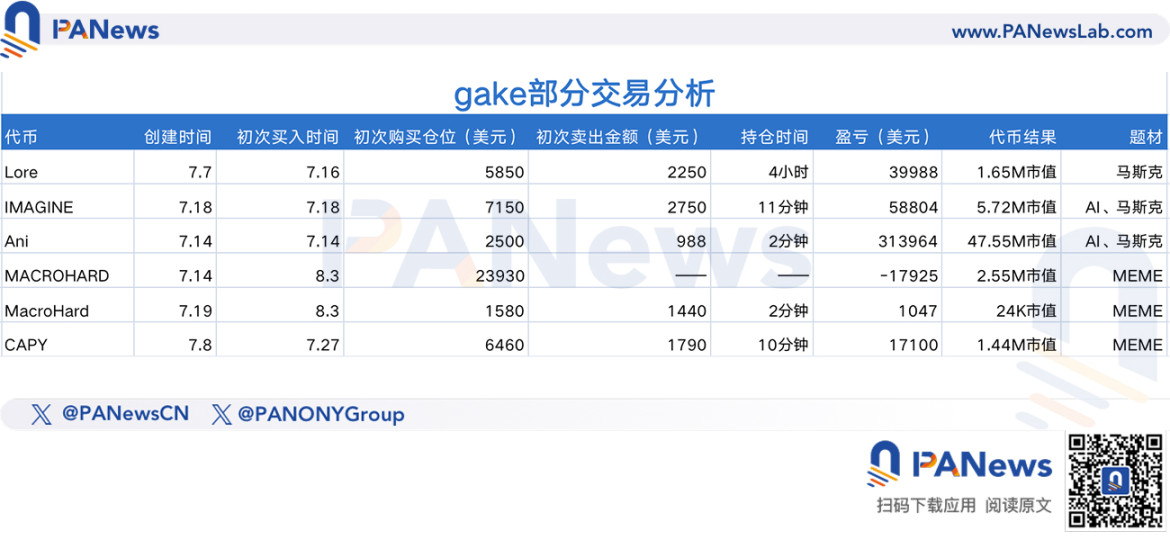
In terms of trading style, Gake usually chooses tokens with a market capitalization of more than $100,000 to trade, and is generally not obsessed with rushing the opening, although sometimes Gake will also buy some tokens in a short period of time after the opening, but it can be observed that he often does this to get lower chips rather than to rush the market.

The first idea of gake is to look for tokens that will return to zero in a short period of time, and at the same time have a certain potential to explode on social media. For example, he usually favors AI, Musk, or MEME culture with an audience base as subject matter choices. It has been observed that the tokens purchased by Gake typically have a market capitalization of more than $1 million.
Second, at the buy point, Gake waits for these tokens to fall back to the price trough or chases breakout entries when there is some positive stimulus. After buying, he will recover a small part of the principal in a short period of time, and choose to let the bullets fly for a while. When encountering some hot tokens, Gake will trade it over and over again, just like trading the bands of altcoins.
Overall, Gake is a diamond hand with a unique way of judging, and his specialty is in finding valuable information, often finding promising topics and meme symbols, and then investing relatively large amounts of money after evaluation.
Cented: "Smart money" trap and manipulation warning
Cented (CyaE1VxvBrahnPWkqm5VsdCvyS2QmNht2UFrKJHga54o) is the third-ranked trader with $1.82 million in gains in the last three months. Cented's trading style is highly similar to Cupsey's, with the same amount of money per investment and even some token varieties. Cented is also a high-frequency way to grab the opening of the market, but compared to Cupsey's trading process of looking for opportunities, Cented is a purer robot trading. His position is held for a shorter time, almost all of which are completed within seconds to tens of seconds, and almost all trades are bought within seconds of opening, which is obviously an address for bot trading.
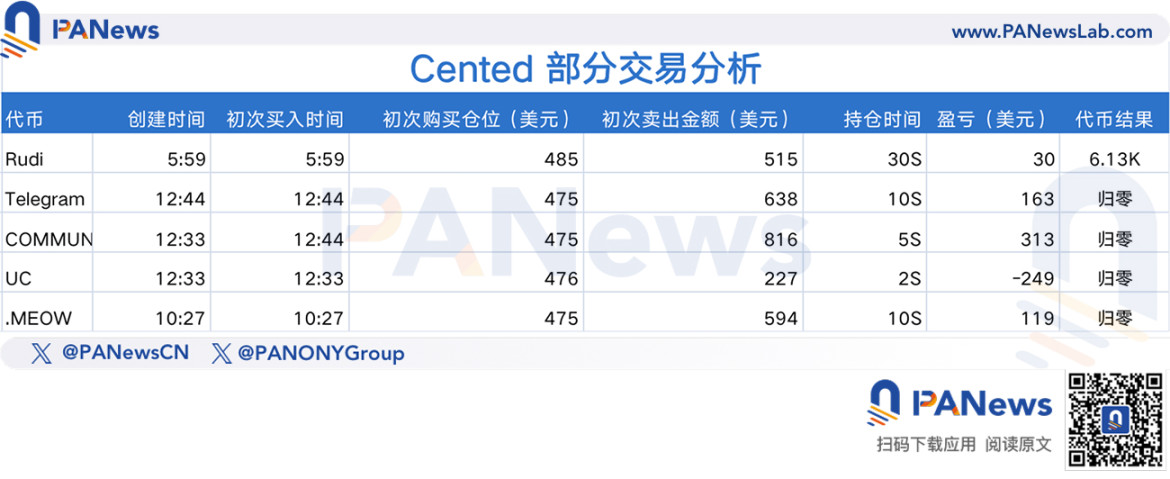
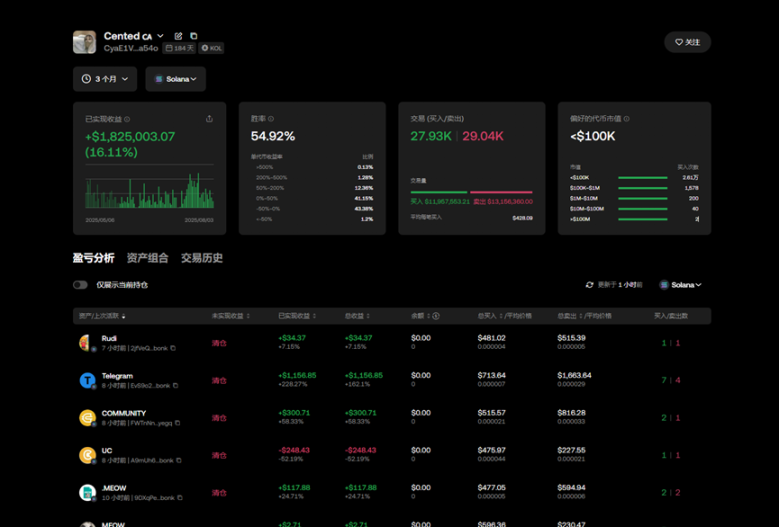
However, it's worth considering that while Cented's bill shows a current profit of $1.82 million, it may not be the actual earnings. The reason is that the tokens purchased by Cented are all new coins that are open, and it is difficult for these newly issued tokens to rise or make a profit if no one else buys them. However, judging from Cented's transaction history, almost more than half of the tokens can achieve profitability, which is obviously inconsistent with the issuance law of MEME coins. Therefore, PANews speculates that the address Cented is likely one of the profitable addresses of some "cabal" addresses, and the so-called gains of this address are mostly caused by other addresses deliberately buying to inflate the price. The reason why the Cented address is kept for a long time to show profitability is to make an address "smart money" so that more people can copy the trade, thus becoming the prey of the "cabal".
PANews randomly looked up several Cented trading tokens and found that their creators, without exception, created addresses for dedicated "conspiracy disks". This phenomenon shows that Cented is either a member of it or specifically buys this "junk" token. But regardless of the facts, copying Cented is not a wise choice for investors.

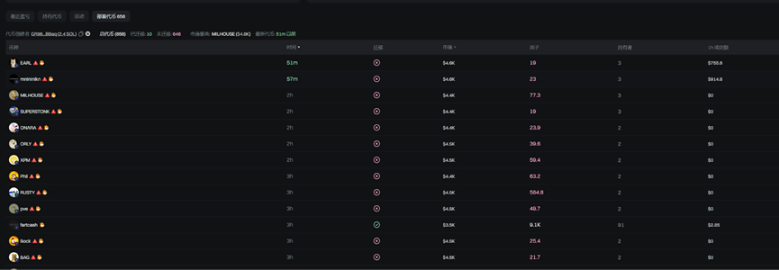

Therefore, for addresses that look like smart money, investors should choose to keep their eyes open and not blindly follow blind trust. In the process of MEME smart money address analysis, we must always be vigilant and analyze whether the apparent profit of the address is consistent with the actual market law. Otherwise, it's easy to fall into the trap of the Rug Group.
All in all, it can be seen from the trading behavior of these top players that true success does not depend on a single lucky bet, but is based on unique trading logic, strong technical foundation, and strict risk control. For ordinary investors, blind copy trading is far less important than understanding the logic and risks behind these strategies. Before diving into this exciting wealth game, maintaining independent thinking and prudent judgment may be the most valuable "smart money" strategy.
